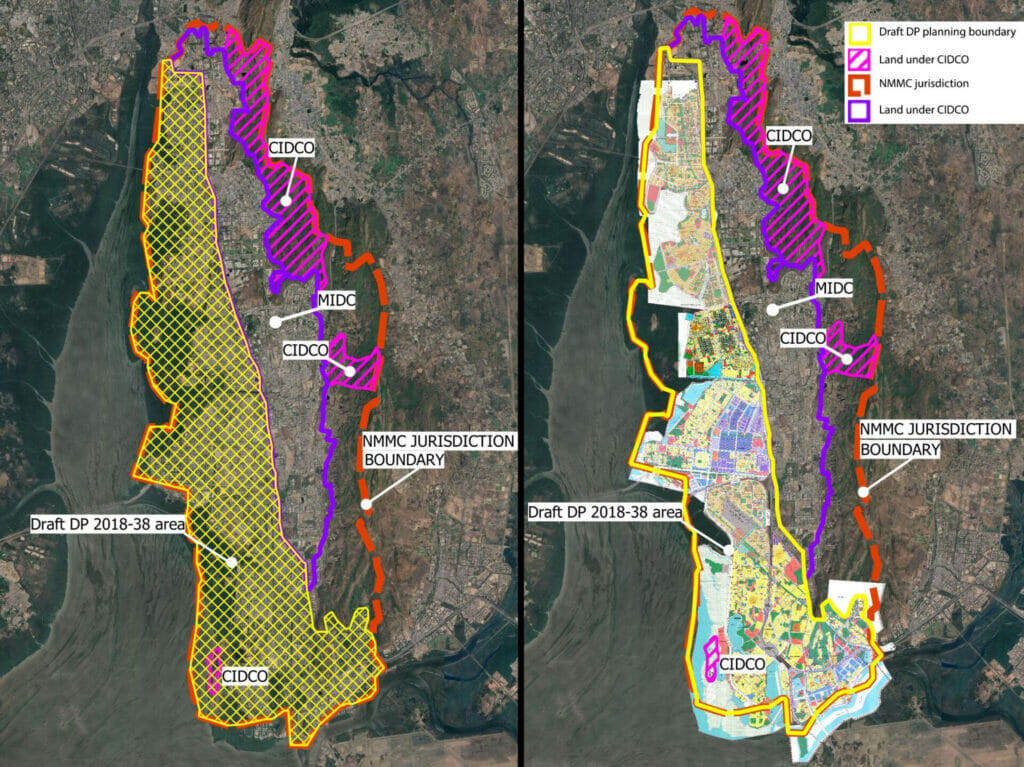The Navi Mumbai Draft Development Plan 2018-2038 is the first development plan to be formulated since the formation of the Municipal Corporation. When Navi Mumbai was conceptualised, planning authorities wanted to decongest Mumbai and shift industrial and housing demands to Navi Mumbai.
Housing has always been one of the primary concerns for the financial capital of the country. The City Industrial Development Corporation (CIDCO), a planning authority in Navi Mumbai, was therefore tasked with the responsibility of identifying land for industrial, residential, commercial usage, etc. [Navi Mumbai Municipal Corporation (NMMC) is the planning authority of Navi Mumbai, but CIDCO and MIDC are the Special Planning Authority for select areas and industrial areas respectively.]
Navi Mumbai grew over a span of more than 50 years through the efforts of informal workers. Youth for Unity and Voluntary Action (YUVA) conducted a survey of select slums in the area. The survey indicated that the workers are involved primarily in construction, domestic work and street vending. Lack of documentation deprives them of access to planned housing for Economically Weaker Sections/Low Income Groups (EWS/LIG) developed by CIDCO. Some of these slums existed even prior to the formation of the Navi Mumbai Municipal Corporation (NMMC).
As of 2011, the population of Navi Mumbai was 11,20,547 people including a slum population of 2.08 lakhs living in 67,327 households in 47 slums. Among those living in slums, 64% owned their homes, 33% lived on rent and 3% lived at their work premises or on the streets.
The draft development plan (DP) report on housing and slums
The draft development plan’s objectives outline the need for minimising inequality, creating more housing stock and redevelopment of slums. It refers to the emerging needs of those living in slums, gaothans and gaothan expansion areas, and old buildings. It also mentions the necessity of redevelopment to upgrade the amenities being given to the people. Referring to the 2011 census for providing details on the slums, the Development Plan Report lists 47 slums within Navi Mumbai.
The DP report delineates a proposed land use reservation for ‘Slum Improvement Zone’ on 0.9% of the city’s land measuring 0.98 sq km. However, the land use maps proposed under the development plan reveal a completely different story.
Also read: Has urban planning in Mumbai failed?
What the proposed land use maps reveal
Primarily, the DP does not mark a single slum on the maps. The proposed land use reservation does not categorise slums as a separate sub category. Among the 47 slums listed in the DP Report, only 11 slums come under the NMMC planning boundary. The rest are on land belonging to CIDCO and Maharashtra Industrial Development Corporation. Given that Maharashtra Industrial Development Corporation (MIDC) and CIDCO are Special Planning Authorities, the future of the majority of slums in the city remains in limbo.
The ‘Slum Improvement Zone’ reservation is not demarcated in the proposed land use maps.
The invisibilisation of slums is evident as the land use maps categorise land currently occupied by slums as residential, forest or recreational areas. When reservations for different types of land use are superimposed on existing slums, they fail to even acknowledge their existence. When coupled with the multiple planning authorities that plan for these areas, they point to an unknown future and in many cases, potential evictions.
What the Development Control Regulations (DCRs) state
The Maharashtra Unified Development Control Promotion Regulation, which is applicable to NMMC planning areas, includes progressive housing options such as inclusive housing, affordable housing for EWS/LIG and designated Slum Improvement Zones as per the Slum Rehabilitation Scheme (SRS). However, the CIDCO DCRs do not have a clear provision for slum upgradation or rehabilitation and the MIDC DCRs only include basic provisions for formal housing for industrial workers. The UDCPR makes it clear that slum redevelopment and the resulting slum Transferable Development Rights are a tailor-made solution for redeveloping existing slums.
Ambiguous governance boundaries and land contestation
CIDCO and NMMC are always contesting for land and the authorities are always locked in powerplay. The draft DP only considers the seven nodes in the NMMC boundary, and ignores large parcels of land which are currently being considered as separate domains. This has resulted in a disjunct planning proposal.

Having ambiguous land boundaries has resulted in anxieties for slum dwellers. The anxiety of living in an undocumented home in a slum, coupled with land disputes between the planning agencies, impacts people’s efforts to gain any form of formal documentation from authorities.
Read more: Why ‘affordable housing’ is just a myth in Mumbai today
Ways forward
The Development Plan needs to acknowledge the present by conducting an Existing Land Use survey. The process must be participative, inclusive and must acknowledge the contribution of thousands of workers, who have built and continue to sustain the city. Counting slums accurately; reserving slum land under ‘Slum Improvement Zone’ or under ‘Public housing’; providing the option of self-development, upgradation and rental housing for migrant families are some of the ways in which the plan can adequately accommodate the housing needs in the city.
If Navi Mumbai is to continue to show Indian cities the way to develop and be an inspiration to further endeavours in planning, it must showcase a way to include slums and the needs they represent even in planned cities. Navi Mumbai must chart its own plan, its own future, just like it did 50 years ago. Most importantly, its elected body must be given the power to do so.
[Summarised by Lalita T. The original article was first published by the non-profit YUVA and has been republished here with permission. The original article can be read here.]